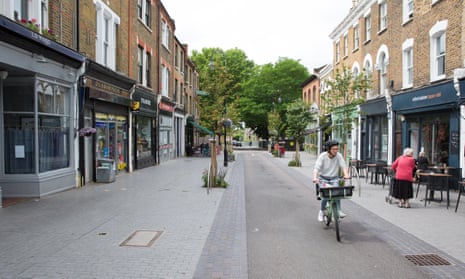The so-called mini-Holland schemes – much-debated changes to boost cycling and walking in outer London boroughs – have done precisely that, according to the first formal study into their impact.
The research found that after one year, people living in parts of such boroughs were, on average, walking and cycling for 41 minutes a week more than those living in comparable areas.
Among the most notable elements of the study, led by Dr Rachel Aldred of Westminster University, is that while the schemes were primarily billed as seeking to boost cycling, the bigger increase in active travel came on foot – an extra 32 minutes weekly on average, with nine more minutes by bike.
The research, published on Tuesday in the journal Transportation Research, studied the travel patterns of just over 1,700 people in three mini-Holland areas – Waltham Forest, Enfield and Kingston – and in various other outer London boroughs which have not seen such changes.
The mini-Holland schemes were announced by Boris Johnson in his second term as London mayor, as an outer London adjunct to the new wave of separated “cycle superhighways” he began to build in the centre.
The mini-Hollands included some separated lanes on main roads, but also other interventions such as systems to make certain streets access-only for motor vehicles while maintaining through routes for bikes.
This made them arguably even more controversial than superhighways, with noisy early opposition including a demonstration outside Walthamstow town hall, and a failed judicial review attempt in Enfield.
One of the main objections was the idea the mini-Hollands would benefit cycling at the expense other other modes. But Aldred’s study says: “We found no evidence of this. For instance, there was no evidence that time spent in cars was increasing (due to congestion), nor that walking environments were becoming less attractive due to the introduction of cycle lanes.”
There was no significant reduction in overall car use in the mini-Holland areas compared with elsewhere. However, those in the boroughs experiencing the new scheme showed a change towards more positive public attitudes to cycling.
It also found the changes seemed to be consistent across demographic and socioeconomic groups, going against another complaint from opponents, that cycle schemes tend to be disproportionately used by white, middle-class travellers.
The paper does seem to show that a certain level of action is needed for the effects to be shown – the effects in “high-dose” mini-Holland areas, which had directly experienced change were notably stronger than “low-dose” neighbourhoods elsewhere in the borough.
The study, which tracked changes between May and June 2016 and the same period a year later, discovered that people in high-dose areas were 24% more likely to have done any cycling in the previous week compared with those in non mini-Holland boroughs.
While in absolute terms the average increase in walking time was greater than for cycling, at 32 minutes against nine minutes, proportionally it was the other way round, with a 13% rise for walking at an 18% increase for cycling.
Aldred, who will continue to study the schemes, said it was notable to see such an impact in the first year of operation: “This includes new uptake of cycling, not just existing cyclists riding more.
“It is also important to note that while the schemes are sometimes perceived as being ‘for cyclists’, they are encouraging more walking – in fact, the increase in walking is greater in absolute terms than the increase in cycling.”
Dr Will Norman, who is in charge of cycling and walking under London’s current mayor, Sadiq Khan, said the mini-Hollands programme – now rebranded “Liveable Neighbourhoods” – had proved its worth.
“This study is further proof that our mini-Holland programme is already making a big difference,” he said. “The fact that more people are choosing to cycle and walk more often brings huge benefits, not only to the health and wellbeing of individual Londoners but also to the wider community. I’m proud that the programme is giving all boroughs the opportunity to bid for funding to make similar positive changes to their areas.”
